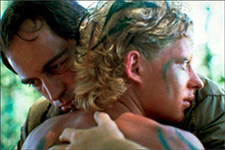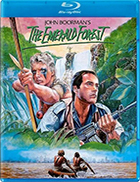The Emerald Forest
|  In The Emerald Forest, director John Boorman returned to the untamed wilds of nature in order to spin a mythic, violent fable about humankind’s environmental destructiveness. He had covered similar territory more than a decade earlier in Deliverance (1972), but where that film succeeded with the terrible force of its brute simplicity, The Emerald Forest often stumbles because it tries to do too much. Deliverance was based on a short novel by a poet, and it had the kind of lean, spare intensity that characterizes much modern poetry. The Emerald Forest, on the other hand, which is loosely “based on a true story,” aspires to be something larger—an unwieldy epic. This is the direction Boorman had been headed all throughout the 1970s and early ’80s, with his twin epic debacles Zardoz (1974) and Exorcist II: The Heretic (1977), as well as the infinitely more successful Arthurian adaptation, Excalibur (1981). But, even if Boorman can be faulted on a narrative level, his cinematic eye is at one with his mythic aspirations. The Emerald Forest, like all of Boorman’s work, is film of immense visual power. There is one particularly heart-rending shot near the beginning of the film, when the seven-year-old son of an American engineer named Bill Markham (Powers Boothe), who is living in Brazil while overseeing the construction of an enormous dam, is snatched by a native tribe that has had no contact with the outside world. Boorman brings his camera in close as Markham pushes his way through vines and leafy foliage, crying out, “Tommy, Tommy!” Then, he stops, with a look of stunned horror on his face. Boorman’s camera then slowly pulls back and up to reveal the vast expanse of the Amazonian rainforest stretching out all around him, seemingly endless in its sheer enormity. It is a stunning moment that establishes the breadth of the wilderness that will dominate the rest of the film. For the next decade, Markham dedicates all his free time to searching the Amazon for his son. Work on the dam progresses, and Markham’s dogged intensity does not wane in the slightest. He learns multiple native languages and becomes an expert survivalist, as he covers territory after territory, carrying with him the feathered end of an arrow from the tribe that took his boy. At this point, it seems that this is what the film is about—one father’s determined quest to retrieve his lost son. Yet, less than an hour into the film, Markham finds Tommy, now a 17-year-old (played by Charley Boorman, the director’s son) who is fully integrated into the tribe that took him, known as the Invisible People. Boorman intercuts scenes of Markham’s search with Tommy’s life among the tribe—hunting with his adoptive father, enduring the tribal ritual into manhood, and claiming a bride in a young woman named Kachiri (Dira Paes). Boorman emphasizes the innocence and natural rhythms of tribal life, and one would be tempted to label him a hopeless idealist if he did not counter the harmony of the Invisible People with another tribe, appropriately known as the Fierce People, who are warlike and engage in cannibalism. The film’s ultimate goal, though, is to indict modern civilization in destroying not only the rainforests (note the film’s title), but the ancient ways of life where we all once lived in tribes and were closer to the natural world that we now destroy to fuel our machines; we can look at it as giving narrative shape to the ideas of Godfrey Reggio’s abstract documentary Koyaanisqatsi (1982). It is later revealed that all of the problems encountered by the Invisible People are directly caused by Markham’s dam project; the son, having returned to his mythic, native roots, is still haunted by the father’s sins. The Invisible People’s battles with the Fierce People come about only because the building of the dam has displaced the latter tribe. Even Markham’s attempts to find his son cause them more problems, as he inadvertently leaves behind a machine gun that the Fierce People learn how to use and employ in a devastating raid on his son’s tribe. The female members of the Invisible People are kidnapped by the Fierce People and sold into prostitution in exchange for bullets and know-how about the machine gun. Markham finds himself aiding Tommy and the remaining men of the tribe in retrieving the women, and in the process reverses his priorities and realizes that his son is better off living the tribal life in the rain forest, rather than returning to the concrete edifices and spiritual discontents of “civilization.” The narrative requires him to make a major decision at the end that some may find ridiculous, even though it works within the film’s thematic scope.When The Emerald Forest falters, much of the problem lies with the script by Rospo Pallenberg, an architect-turned-filmmaker who previously worked with Boorman as a “creative associate” on Deliverance and Exorcist II and co-wrote Excalibur. The structure is unwieldy and pulls us in too many different directions without an underlying cohesiveness to hold it together. Pallenberg was reportedly inspired to write the script based on a story published in the The Los Angeles Times in 1972 about a Peruvian man whose child was taken by an indigenous tribe and assimilated into their culture. He also appears to have been inspired by the 1971 autobiographical book Wizard of the Upper Amazon by Manuel Córdova-Rios, who was taken as a teenager in the early 1900s by a tribe with whom he then lived for seven years. Thus, while the film opens with a disclaimer insisting on the fact that it was “based on real events and actual characters,” it is primarily a fiction. Even if the film largely falls apart in its second half, Boorman still manages to keep it viscerally exciting and entertaining. He stages a number of action sequences that are thrilling in their own right, especially a hunt in which Markham becomes the target of the Fierce People. The cinematography by veteran Philippe Rousselot (who would go on to win an Oscar a few years later for 1992’s A River Runs Through It) emphasizes the raw beauty of the Amazonian rainforest, contrasting large, sweeping panoramas that stress its enormity with close, intimate shots of wildlife going about their routines. There is an embedded irony of the grand aerial shots of the rainforest because they instill a sense of vastness that is countered by the always evident realization that the modern world is encroaching, cutting down thousands of acres each day. The eye can be deceiving, Boorman seems to be saying. Don’t be lulled into complacency just because the wilderness appears so vast as to be indestructible. If the rainforest constitutes another world in which people live as they have for tens of thousands of years, it is a world that is in imminent danger of extinction, however impossible that may seem. It is quite appropriate, in this respect, that the Invisible People refer to the line at which the forest ends and the barren, cleared space of the dam project begins as “The Edge of the World.”
Copyright © 2023 James Kendrick Thoughts? E-mail James Kendrick All images copyright © Kino Lorber | |||||||||||||||||||||||||||||
Overall Rating: 

 (2.5)
(2.5)


